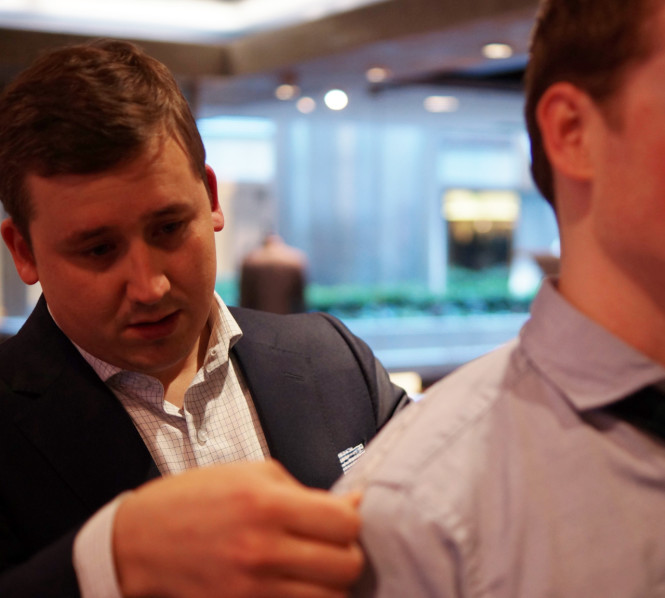Part II: Measurements and Fitting
Previously: Part I
After poring over fabric books, lapel styles, and horn buttons for a couple hours with Dustin I was ready to begin the most important part of the made-to-measure experience – the fitting. Picking fabric and style options is lots of fun (although my choices were very tame), but the most crucial part of the process is making sure that you are properly measured.
Beckett & Robb’s measurement process consists of many body measurements as well as garment adjustments taken from some standard-sized suits in the store. The measurements are very thorough and account for a variety of parameters outside of what the standard online MTM companies offer. Things like shoulder slope, posture, sleeve pitch, button stance, and trouser rise (both front and back) are all very important to a well-fitting suit but are generally not captured in a “blind” MTM experience since they are difficult to determine with a measuring tape. Of course, I have yet to see how the final product incorporates these values but it was good to know that they were acknowledged and included.
The suit samples (made of a Loro Piana grey worsted wool) were helpful in that they gave a general idea of what the final product might look like. My suit won’t look that similar to the sample I worked with (no skinny lapels, for instance), but it helped me see changes in real time and how they might affect the end product. For instance, button stance is a powerful factor in a suit’s look but it can be hard to visualize. The samples allowed me to see the effects of moving it up and down directly (I moved it down to a slightly more traditional level).
One particular area that Dustin and I spent a lot of time poring over was my shoulders and deciding how to best address them. You see, although I have a slim build I have surprisingly broad shoulders with a heavy slope. The slope in particular causes problems and is difficult to address well. In the end we went with a lightly padded shoulder that hopefully will address my heavy slope in an attractive way. I know shoulders with any padding at all seem almost passé at the moment but it’s a classic silhouette (especially for a suit) and at the end of the day I relate more with the British tailoring traditions than with the Neopolitan style that is so popular nowadays. I am a descendant of Caledonia and the Emerald Isles, after all. Anyway, I’m curious to see how they turn out.
All in all, Dustin was very capable and seemed to have a good handle on what he was doing. It should go without saying that the end result can only be as good as the person measuring it (which is why blind MTM suits can be so risky), so I was pleased that Dustin and I had similar taste and wanted the same things from the fitting. I was also able to rely on Dustin when my own knowledge was lacking – although I like to pretend to have a wealth of knowledge on things like this there are certainly topcis I don’t fully understand and Dustin was able to offer good advice when needed.
As could be expected from a perfectionist like myself, I find it easy to work myself into a tizzy about whether the suit will fit right or not. To me, though, that’s almost part of starting a clothing commission with a new company – the fear and excitement of waiting for a product being made solely for you. My suit should be arriving in the next week or two, so we’ll soon find out.


